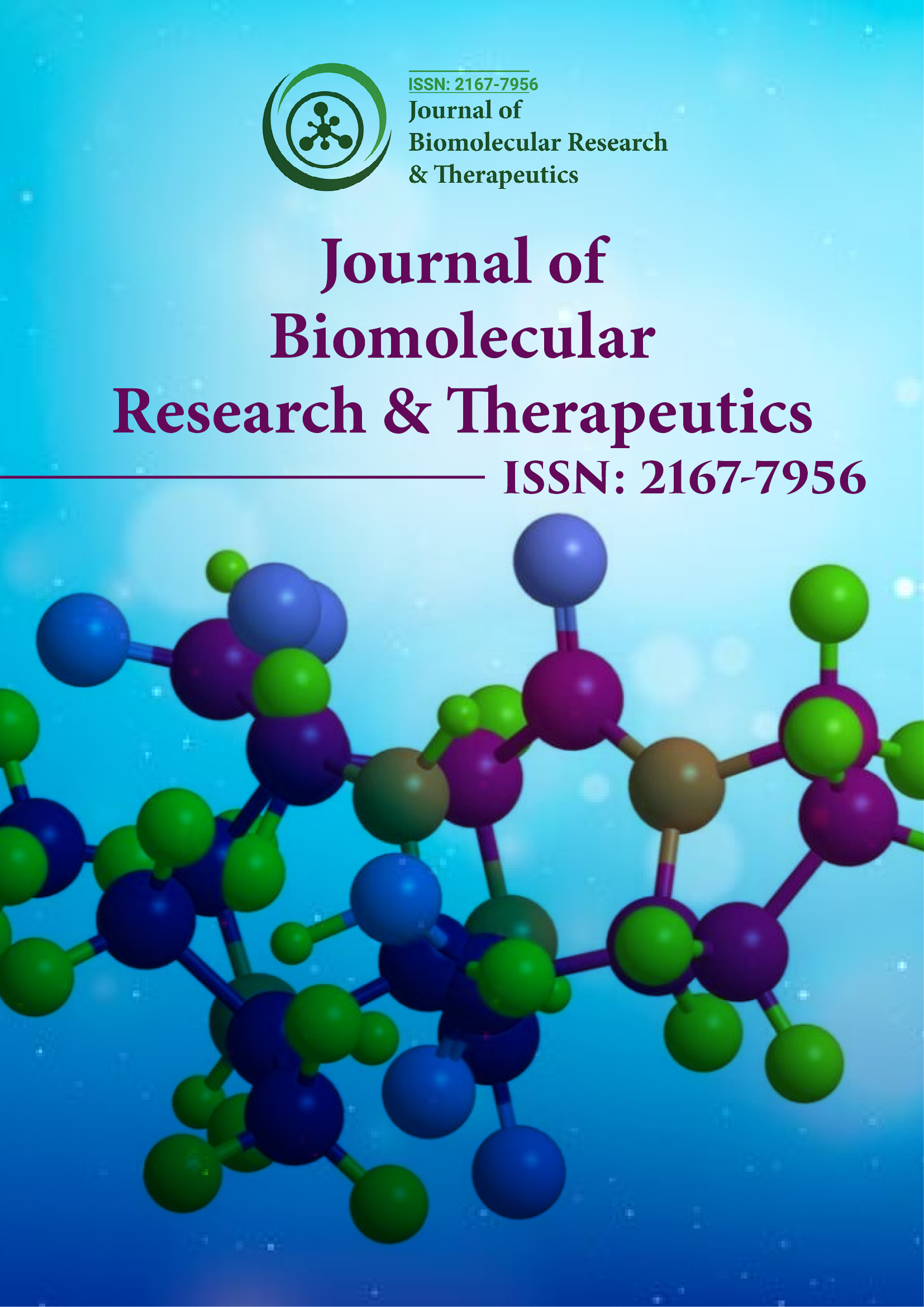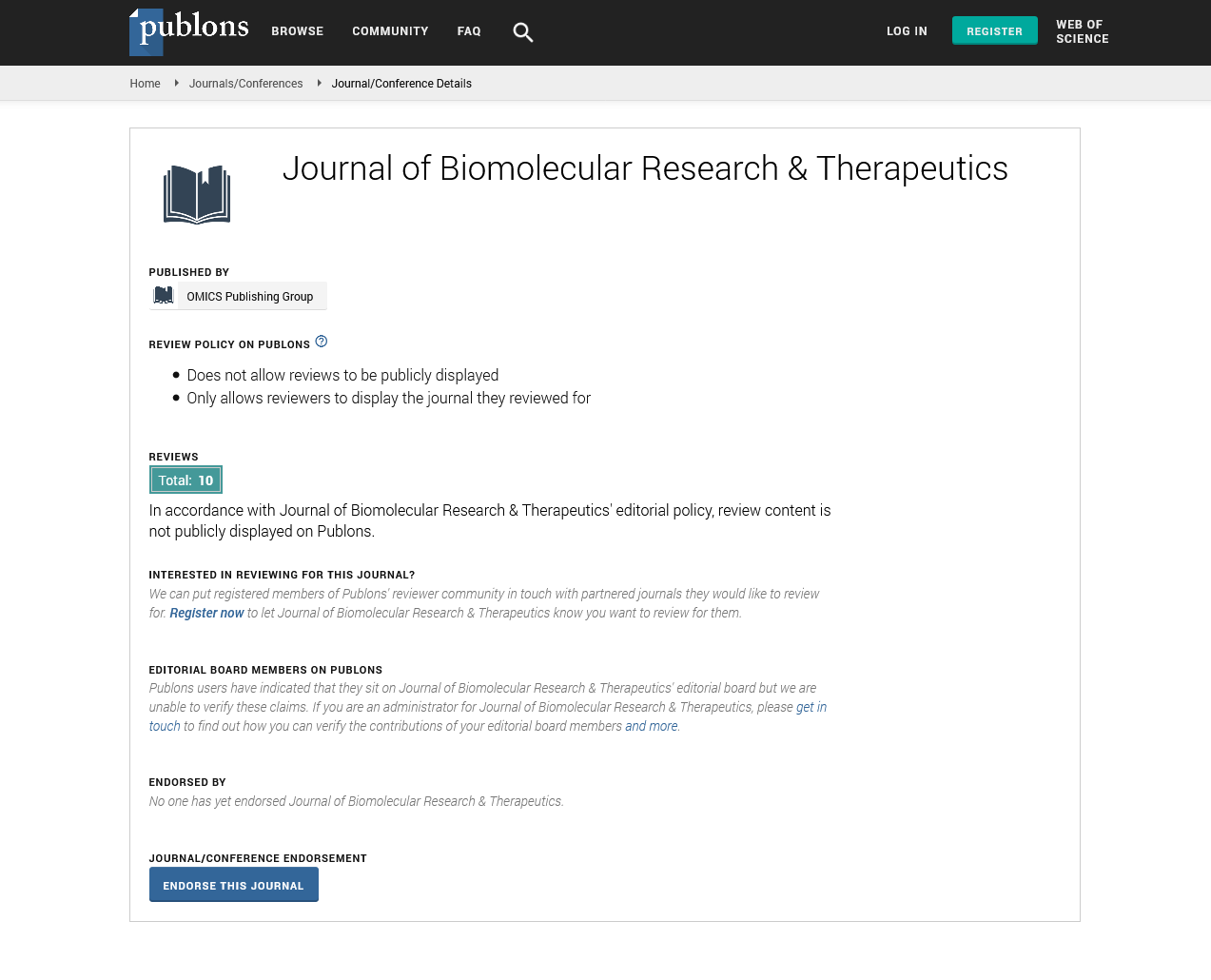Indexed In
- Open J Gate
- Genamics JournalSeek
- ResearchBible
- Electronic Journals Library
- RefSeek
- Hamdard University
- EBSCO A-Z
- OCLC- WorldCat
- SWB online catalog
- Virtual Library of Biology (vifabio)
- Publons
- Euro Pub
- Google Scholar
Useful Links
Share This Page
Journal Flyer

Open Access Journals
- Agri and Aquaculture
- Biochemistry
- Bioinformatics & Systems Biology
- Business & Management
- Chemistry
- Clinical Sciences
- Engineering
- Food & Nutrition
- General Science
- Genetics & Molecular Biology
- Immunology & Microbiology
- Medical Sciences
- Neuroscience & Psychology
- Nursing & Health Care
- Pharmaceutical Sciences
Short Communication - (2024) Volume 13, Issue 5
Phase Separation and RNA: Mechanisms behind Biomolecular Condensates
Lien Wadsworth*Received: 30-Sep-2024, Manuscript No. BOM-24-27796; Editor assigned: 02-Oct-2024, Pre QC No. BOM-24-27796 (PQ); Reviewed: 16-Oct-2024, QC No. BOM-24-27796; Revised: 23-Oct-2024, Manuscript No. BOM-24-27796 (R); Published: 30-Oct-2024, DOI: 10.35248/2167-7956.24.13.413
Description
Biomolecular condensates are membrane-less organelles that form through phase separation, a process that enables the aggregation of macromolecules into concentrated regions within cells. These condensates play an important role in regulating cellular processes by compartmentalizing various biochemical reactions. The formation of these condensates is driven by interactions between proteins, nucleic acids and other molecules. Recently, research has focused on the role of RNA in driving phase transitions in biomolecular condensates, revealing new insights into the complexity of cellular organization.
Phase separation refers to the process by which a homogenous solution of biomolecules separates into two distinct phases: A dense phase (the condensate) and a dilute phase. This process is akin to how oil and water separate when mixed, but in biological systems, it is driven by weak, multivalent interactions between the components involved, such as RNA, proteins and small molecules. Unlike membrane-bound organelles, phase-separated biomolecular condensates are dynamic and constantly change in response to cellular needs [1-3].
RNA plays a central role in driving phase transitions in biomolecular condensates. RNA molecules, with their diverse secondary structures and sequences, possess the ability to interact with proteins and other RNA molecules, promoting the self-assembly of condensates. These interactions are driven by the multivalent binding sites on RNA molecules that facilitate the recruitment of proteins, often rich in Low-Complexity Domains (LCDs). These proteins possess the ability to bind to multiple RNA molecules or other proteins, leading to the formation of larger, more concentrated aggregates [4,5]. The process of RNA-driven phase separation is highly influenced by the specific sequence and structure of the RNA. For example, messenger RNAs (mRNAs) that carry the genetic instructions for protein synthesis are involved in forming RNA-protein condensates that are essential for processes like mRNA splicing, translation and degradation. These condensates, such as stress granules or Pbodies, concentrate RNA-binding proteins and mRNA to coordinate gene expression in response to cellular stress or other environmental signals [6-8].
One of the key features of RNA-driven phase transitions is the ability of RNA molecules to mediate the formation of liquid-like droplets. These droplets can undergo rapid fusion, fission and reorganization, much like liquid droplets in water. The liquid like properties of RNA-driven condensates enable cellular components to be compartmentalized efficiently without the need for a membrane. These condensates can also serve as dynamic hubs for biochemical reactions, allowing the assembly of molecular machines or the storage of specific RNA species for later use. In addition, phase separation of RNA-protein complexes can provide a means for the cell to quickly respond to changes in the environment or cellular needs.
RNA molecules, particularly long non-coding RNAs (lncRNAs) and small RNAs, are also involved in organizing biomolecular condensates that regulate cellular processes such as transcription, RNA processing and protein localization. By promoting the clustering of specific proteins, RNA-driven condensates allow cells to streamline complex biological processes. In some cases, these condensates also function as reservoirs for proteins, enabling their rapid activation or sequestration depending on the cell's needs. In this way, RNA-driven phase transitions serve not only to compartmentalize cellular components but also to regulate their availability and activity [9].
However, the formation and function of RNA-driven biomolecular condensates are not without challenges. Dysregulation of these phase transitions can lead to diseases such as neurodegenerative disorders, cancers and other conditions. For instance, the abnormal phase separation of RNA-binding proteins has been implicated in the formation of toxic aggregates in diseases like Amyotrophic Lateral Sclerosis (ALS) and frontotemporal dementia. These aggregates disrupt normal cellular processes and contribute to the disease pathology. Therefore, understanding the mechanisms behind RNA-driven phase transitions is not only important for understanding cellular organization but also for identifying potential therapeutic targets for treating diseases associated with phase separation [10].
The physical principles that govern RNA-driven phase transitions are complex and involve a combination of entropy-driven processes and specific molecular interactions. The RNA molecules themselves provide a scaffold for the assembly of proteins and other components, while the protein-RNA interactions drive the condensation of these components into droplets. This process is modulated by environmental factors such as temperature, ionic strength and the concentration of specific biomolecules. For instance, certain ions or small molecules can promote or inhibit phase separation, further influencing the behavior of biomolecular condensates within the cell.
Conclusion
In conclusion, RNA-driven phase transitions are important mechanisms for the formation and regulation of biomolecular condensates. These condensates allow cells to compartmentalize biochemical reactions and regulate the availability of proteins and RNA species. The study of RNA-driven phase separation provides new insights into the dynamic and adaptable nature of cellular organization. As research continues, understanding how RNA and proteins interact to form these condensates will likely lead to further discoveries about cellular function and disease. These findings may also pave the way for novel therapeutic strategies to address diseases associated with dysregulated phase separation.
References
- Nudler E. RNA polymerase active center: The molecular engine of transcription. Annu Rev Biochem. 2009;78:335-361.
[Crossref] [Google Scholar] [PubMed]
- Clarke J, Wilhelm FK. Superconducting quantum bits. Nature. 2008;453:1031-1042.
[Crossref] [Google Scholar] [PubMed]
- Bennett R, Barlow TM, Beige A. A physically motivated quantization of the electromagnetic field. Eur J Phys. 2016;37:014001.
- Kohestani H, Wereszczynski J. The effects of RNA.DNA-DNA triple helices on nucleosome structures and dynamics. Biophys J. 2023;122:1229-1239.
[Crossref] [Google Scholar] [PubMed]
- Du X, Qin W, Yang C, Dai L, San M, Xia Y, et al. RBM22 regulates RNA polymerase II 5′ pausing, elongation rate and termination by coordinating 7SK-P-TEFb complex and SPT5. Genome Biol. 2024;25:102.
[Crossref] [Google Scholar] [PubMed]
- Klein CA, Teufel M, Weile CJ, Sobetzko P. The bacterial promoter spacer modulates promoter strength and timing by length, TG-motifs and DNA supercoiling sensitivity. Sci Rep. 2021;11:24399.
[Crossref] [Google Scholar] [PubMed]
- Xu J, Chong J, Wang D. Opposite roles of transcription elongation factors Spt4/5 and Elf1 in RNA polymerase II transcription through B-form versus non-B DNA structures. Nucleic Acids Res. 2021;49:4944-4953.
[Crossref] [Google Scholar] [PubMed]
- Korzheva N, Mustaev A, Kozlov M, Malhotra A, Nikiforov V, Goldfarb A, et al. A structural model of transcription elongation. Science. 2000;289:619-625.
[Crossref] [Google Scholar] [PubMed]
- Yun K. Two types of electric field enhancements by infinitely many circular conductors arranged closely in two parallel lines. Q Appl Math. 2017;75:649-676.
- Sabari BR, Dall’Agnese A, Young RA. Biomolecular condensates in the nucleus. Trends Biochem Sci. 2020;45:961-977.
[Crossref] [Google Scholar] [PubMed]
Citation: Wadsworth L (2024). Phase Separation and RNA: Mechanisms behind Biomolecular Condensates. J Biomol Res Ther. 13:413.
Copyright: © 2024 Wadsworth L. This is an open-access article distributed under the terms of the Creative Commons Attribution License, which permits unrestricted use, distribution, and reproduction in any medium, provided the original author and source are credited.

